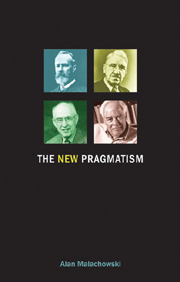Book contents
- Frontmatter
- Contents
- Preface
- Acknowledgements
- Abbreviations
- 1 Introducing the New Pragmatism
- 2 Leaving classic pragmatism behind
- 3 Rorty against the tradition
- 4 Putnam's contributions
- 5 Putnam and Rorty: pragmatism without reconciliation
- 6 Prospects
- Conclusion: the New Pragmatism and philosophy
- Notes
- Reading the New Pragmatists
- Bibliography
- Index
1 - Introducing the New Pragmatism
- Frontmatter
- Contents
- Preface
- Acknowledgements
- Abbreviations
- 1 Introducing the New Pragmatism
- 2 Leaving classic pragmatism behind
- 3 Rorty against the tradition
- 4 Putnam's contributions
- 5 Putnam and Rorty: pragmatism without reconciliation
- 6 Prospects
- Conclusion: the New Pragmatism and philosophy
- Notes
- Reading the New Pragmatists
- Bibliography
- Index
Summary
There is absolutely nothing new in the pragmatic method.
(William James, Pragmatism and The Meaning of Truth)Pragmatism, when looked at in wide perspective and against the background of earlier epochs of philosophic thought, is justified in thinking of itself as ‘a new way of thinking’.
(Milton K. Munitz, Contemporary Analytic Philosophy)The aim of this book is to provide a broad-based introduction to the New Pragmatism for those who are to a large extent, or perhaps even completely, unfamiliar with it. In tackling that task, it ranges over five large questions: what is the New Pragmatism? Why has it come into prominence in recent years? What, if anything, is new about it? What are its main strengths? And what are its prospects?
In dealing with such big questions, the book cannot help but evoke further issues. Some of these are subsidiary, and hence disposable. Others are quite important. However, most of the latter, especially those involving complex matters of history and textual interpretation, cannot be dealt with in the space available. And the others simply have little relevance to an introductory project of this kind. Furthermore, the overarching goal here is to cut through such complexities in order to provide a clear, accessible, general guide to the New Pragmatism, one that explains what it involves in the most general sense, why it has created such an intellectual stir in many quarters1 and what makes it so interesting and challenging at the present time.
- Type
- Chapter
- Information
- The New Pragmatism , pp. 1 - 16Publisher: Acumen PublishingPrint publication year: 2009



